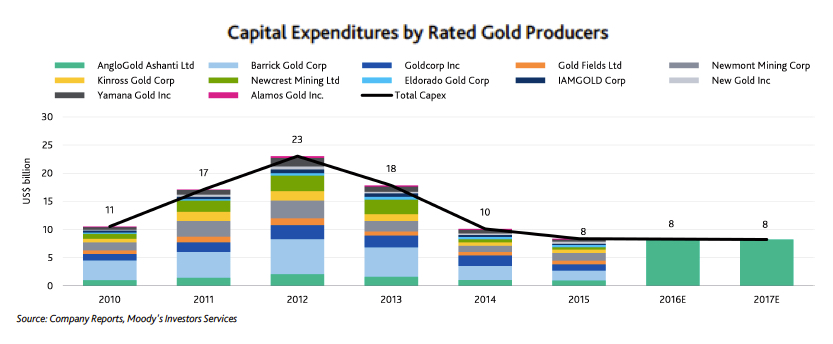
It took a couple of years for gold producers to begin making radical cutbacks to their capital expenditure programs after the gold price started the decline from its 2011 peak.
In 2012 capital expenditure at the world’s largest gold miners peaked at $23 billion and the following year also topped 2011’s tally as projects embarked on at the height of the gold boom were brought to fruition.
Last year overall spending fell to $8 billion and when stripping out sustaining capex, the decline is even starker with one study pointing to a more than 80% fall in new project spending from the 2012 peak.
In a new research note Moody’s Investors Services argues that the ability of the gold producers to maintain their production profiles versus capital preservation has become a key factor when assigning credit worthiness.
This risk has become especially pronounced beyond the next two years, when we anticipate future production could decline as a result of diminished spending on growth and development in favour of conserving cash
The ratings agency expects capex to stay at $8 billion levels for the next two years and says falling production and cash flows if not coupled with debt reduction is injecting risk into the sector:
“When looking back to the elevated capital expenditures by our universe of gold producers from 2011 to 2013, we do not see a corresponding increase in production. Though we note there have been asset sales within the time frame we are looking at, we also believe there has been sizable investment that has not resulted in more production – this points to suspended development projects.
“This risk has become especially pronounced as we look beyond the next two years, when we anticipate future production could decline as a result of diminished spending on growth and development in favour of conserving cash.”
Top gold miner by output Barrick Gold is targeting 6.1 million ounces this year – down from a peak of 7.7 million in 2010–2011. Next year the Toronto-based giant said production could fall as low as 5 million ounces and below that by 2018.
Vancouver’s Goldcorp lowered its production forecast for to 2.8 – 3.1 million ounces from 2016 to 2018 from about 3.5 million ounces in 2015 driven by production declines at older mines although its $520 acquisition of the Yukon’s Kaminak Gold last week would boost output further out.
While others are disposing of mines, Newmont Mining is building its portfolio and last year acquired the Cripple Creek & Victor gold mine in Colorado. Newmont also has five key projects that are in execution stage including the Turf Vent project in Nevada and Merian mine in South America expected to start production late in 2016.
That could see the Denver-based company potentially overtake Barrick as soon as this year if results come in at the higher end of production guidance of 5.3 million ounces.
World number three producer Anglogold-Ashanti’s production guidance for 2016 is between 3.6 – 3.8 million ounces, down from 3.95 million ounces last year. As an indication of the dearth of new project spending in the sector the Johannesburg-based company has set aside only $120–$140 million for that purpose in 2016.

Source: Moody’s Investors Services
Comments
Goldfinger
Wow. Newsflash to the gold miners. To have new production you need projects. Now I know this might come as a surprise to all of them. The next step the market and financial analysts need to take is to have a look at all of the ounces that are on the boards as proven reserves and evaluate if it is all just a wet dream. For Newmont look at Minas Conga, for Barrick look at Pascua Lama and for Anglo Gold Ashanti, look at La Colosa. Those projects will never be built, so take the ounces off the boards. Actually the could be built but not with the crews they have or never spending any money on studies.